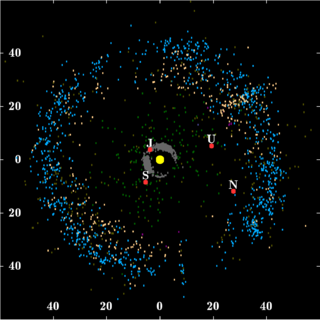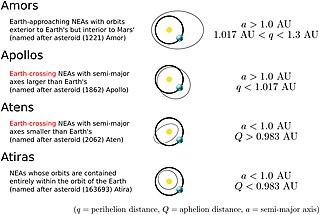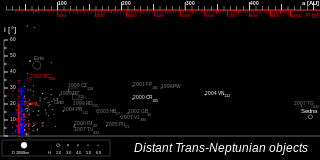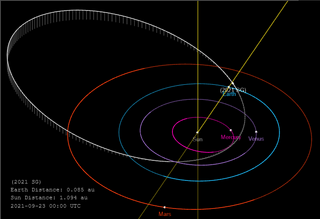Members
Inner grazers
The following is a list of named asteroids that are not Jupiter trojans with a<4.950429, 4.950429<Q<5.458104.
| Numerical designation | Name | Semimajor axis (a) | Perihelion (q) | Aphelion (Q) | Inclination (i) | TJup |
|---|---|---|---|---|---|---|
| 1941 | Wild | 3.9576687 | 2.8123327 | 5.1030047 | 3.9576688 | 2.980 |
| 2483 | Guinevere | 3.9660605 | 2.8648120 | 5.0673089 | 4.5018307 | 2.984 |
| 2959 | Scholl | 3.9639072 | 2.8845027 | 5.0433117 | 5.2266660 | 2.985 |
| 3415 | Danby | 3.9758047 | 2.9821889 | 4.9694204 | 1.3720066 | 3.001 |
| 4446 | Carolyn | 3.9847309 | 2.8654604 | 5.1040014 | 7.2437749 | 2.972 |
| 5370 | Taranis | 3.3201194 | 1.2050313 | 5.4352075 | 19.1663375 | 2.730 |
| 8373 | Stephengould | 3.2793924 | 1.4599527 | 5.0988320 | 40.7988751 | 2.587 |
| 8550 | Hesiodos | 3.9469702 | 2.9183717 | 4.9755688 | 2.8770596 | 2.998 |
| 9767 | Midsomor Norton | 3.3876184 | 1.4614187 | 5.3138182 | 21.4765793 | 2.771 |
| 10608 | Mameta | 3.9970925 | 2.9733157 | 5.0208692 | 4.5213778 | 2.991 |
| 12896 | Geoffroy | 3.9656152 | 2.8304429 | 5.1007875 | 6.3396988 | 2.975 |
| 15231 | Ehdita | 3.9420298 | 2.7859763 | 5.0980833 | 6.8145092 | 2.972 |
| 15376 | Marták | 3.9405888 | 2.7198112 | 5.1613665 | 2.898672 | 2.973 |
| 15783 | Briancox | 3.9533527 | 2.9347246 | 4.9719808 | 4.8458548 | 2.995 |
| 20038 | Arasaki | 3.9885244 | 3.0254297 | 4.9516191 | 19.5588206 | 2.906 |
| 21804 | Václavneumann | 3.9358785 | 2.8792005 | 4.9925564 | 3.8389635 | 2.994 |
| 61042 | Noviello | 3.9821252 | 2.9119354 | 5.0523150 | 9.5445462 | 2.969 |
| 73769 | Delphi | 3.9821229 | 2.9425211 | 5.0217246 | 1.9002573 | 2.995 |
| 84011 | Jean-Claude | 4.0101019 | 3.0215759 | 4.9986279 | 4.0124416 | 2.995 |
| 99862 | Kenlevin | 3.9505605 | 2.9191583 | 4.9819627 | 10.0886018 | 2.973 |
| 100231 | Monceau | 3.9574767 | 2.7911890 | 5.1237644 | 2.7823358 | 2.980 |
| 113415 | Rauracia | 3.9888370 | 2.9525987 | 5.0250753 | 11.1590108 | 2.963 |
| 117993 | Zambujal | 4.0204050 | 2.9487023 | 5.0921078 | 1.8573524 | 2.988 |
| 134039 | Stephaniebarnes | 3.9789971 | 2.9130231 | 5.0449711 | 9.6741502 | 2.969 |
| 154932 | Sviderskiene | 3.9711154 | 2.9828014 | 4.9594295 | 1.6191862 | 3.002 |
| 173108 | Ingola | 3.9583783 | 2.6575983 | 5.2591584 | 0.7598889 | 2.962 |
| 249302 | Ajoie | 3.9292547 | 2.7432650 | 5.1152443 | 5.6092116 | 2.973 |
| 402920 | Tsawout | 3.9350116 | 2.8614202 | 5.0086031 | 12.1172083 | 2.958 |
Outer grazers
Similar to inner grazers, these orbit with a semi-major axis greater than Jupiter, but still have a perihelion distance within Jupiter's perihelion and aphelion, a>5.458104 and 4.950429<q<5.458104.
| Provisional designation | Number | Semimajor axis (a) | Perihelion (q) | Aphelion (Q) | Inclination (i) | TJup |
|---|---|---|---|---|---|---|
| 2008 QD4 | 315898 | 8.42410 | 5.450462 | 11.39774 | 42.01641 | 2.387 |
| 2000 GQ148 | 461363 | 6.415034 | 5.10450 | 7.72557 | 15.81763 | 2.903 |
| 2004 CM111 | 33 | 5.00 | 60 | 4.67 | 2.814 | |
| 2005 VD | 434620 | 6.66224 | 4.98632 | 8.33816 | 172.8655 | -1.392 |
| 2008 HY21 | 10.9163 | 5.38371 | 16.4489 | 11.99664 | 2.919 | |
| 2010 GW147 | 174.8 | 5.38093 | 344.2 | 99.62267 | -0.447 | |
| 2010 XZ78 | 523649 | 7.6617 | 5.39009 | 9.9333 | 39.2351 | 2.474 |
| 2011 WR74 | 9.00 | 5.19 | 12.82 | 10.899 | 2.917 | |
| 2013 CJ118 | 10 | 5.2 | 16 | 10 | 2.914 | |
| 2013 EK73 | 437313 | 13.0189 | 5.39096 | 20.647 | 8.98504 | 2.932 |
| 2013 FU61 | 9.21 | 5.35 | 13.06 | 19.55 | 2.842 | |
| 2014 RE12 | 14.31 | 5.082 | 23.53 | 31.55 | 2.524 |
Jupiter crossers
These are asteroids that cross the orbit of Jupiter in any sort of way, defined simply as having a perihelion less than that of Jupiter's perihelion, and an aphelion greater than Jupiter's aphelion.
| Number | Name/Designation | Semimajor axis (a) | Perihelion (q) | Aphelion (Q) | Inclination (i) | TJup |
|---|---|---|---|---|---|---|
| 944 | Hidalgo | 5.73650908 | 1.9415260 | 9.5315921 | 42.52454 | 2.068 |
| 3552 | Don Quixote | 4.22198210 | 1.2099156 | 7.23404861 | 31.029816 | 2.314 |
| 5164 | Mullo | 3.69327190 | 1.8504846 | 5.53605921 | 19.278250 | 2.787 |
| 5335 | Damocles | 11.831 | 1.57294 | 22.090 | 62.0845 | 1.143 |
| 6144 | Kondojiro | 4.75035383 | 3.0319800 | 6.4687276 | 5.887297 | 2.868 |
| 15504 | 1999 RG33 | 9.3964 | 2.149710 | 16.6431 | 34.9021 | 1.957 |
| 18916 | 2000 OG44 | 3.84737395 | 1.5936645 | 6.10108342 | 7.41703 | 2.735 |
| 20461 | Dioretsa | 23.776 | 2.390026 | 45.162 | 160.40358 | -1.541 |
| 20898 | Fountainhills | 4.22660409 | 2.26088477 | 6.1923234 | 45.52005 | 2.349 |
| 32511 | 2001 NX17 | 5.0369831 | 2.8877697 | 7.1861964 | 8.932579 | 2.791 |
| 37117 | Narcissus | 6.873395 | 3.06464 | 10.682154 | 13.81436 | 2.615 |
| 65407 | 2002 RP120 | 54.888 | 2.483516 | 107.292 | 119.10563 | -0.845 |
| 85490 | 1997 SE5 | 3.70679069 | 1.2225315 | 6.1910499 | 2.599906 | 2.655 |
| 144908 | 2004 YH32 | 8.1620 | 3.548172 | 12.7757 | 79.09398 | 1.028 |
| 145485 | 2005 UN398 | 4.5991409 | 2.2133475 | 6.9849344 | 11.550620 | 2.706 |
| 145627 | 2006 RY102 | 6.348164 | 4.5909472 | 8.105381 | 18.699958 | 2.830 |
| 154784 | 2004 PA44 | 14.2313 | 3.451766 | 25.0108 | 3.27983 | 2.522 |
| 187799 | 1999 FK16 | 4.2757264 | 3.050283 | 5.5011694 | 17.36476 | 2.875 |












